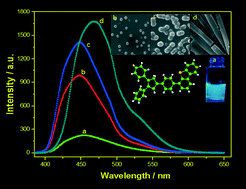Morphology-controlled assembly and enhanced emission of fluorescence in organic nanospheres and microrods based on 1,2-diphenyl-4-(4-dibenzothienyl)phenyl-1,3-cyclopentadiene†
Abstract
Fluorescent organic nanospheres, pod-like connecting spheres and microrods based on 1,2-diphenyl-4-(4-dibenzothienyl)phenyl-1,3-cyclopentadiene (DPCP) have been prepared via controlling the solvent composition. The influence of concentration, surfactants and solvents on the morphologies of products was examined. The formation of particles with different morphologies could be attributed to the solubility-controlled crystalline nucleation. Single crystal X-ray analysis reveals that the molecule of DPCP has a non-coplanar geometry, and two molecules are packed to form a dimer as an X-aggregate. Further, one-dimensional chains of DPCP additionally avoided the maximum face-to-face stacking. The solution of DPCP in methanol has weaker emission with a peak at 455 nm, however, the nanospheres, pod-like connecting spheres and microrods exhibited remarkably enhanced fluorescence emission with peaks at 447, 448 and 468 nm, respectively. Additionally, fluorescence change behavior was further verified by DFT calculation and time-resolved emission decay measurements.


 Please wait while we load your content...
Please wait while we load your content...